NASA’s Return to the Moon Reignites Life in Coastal Florida
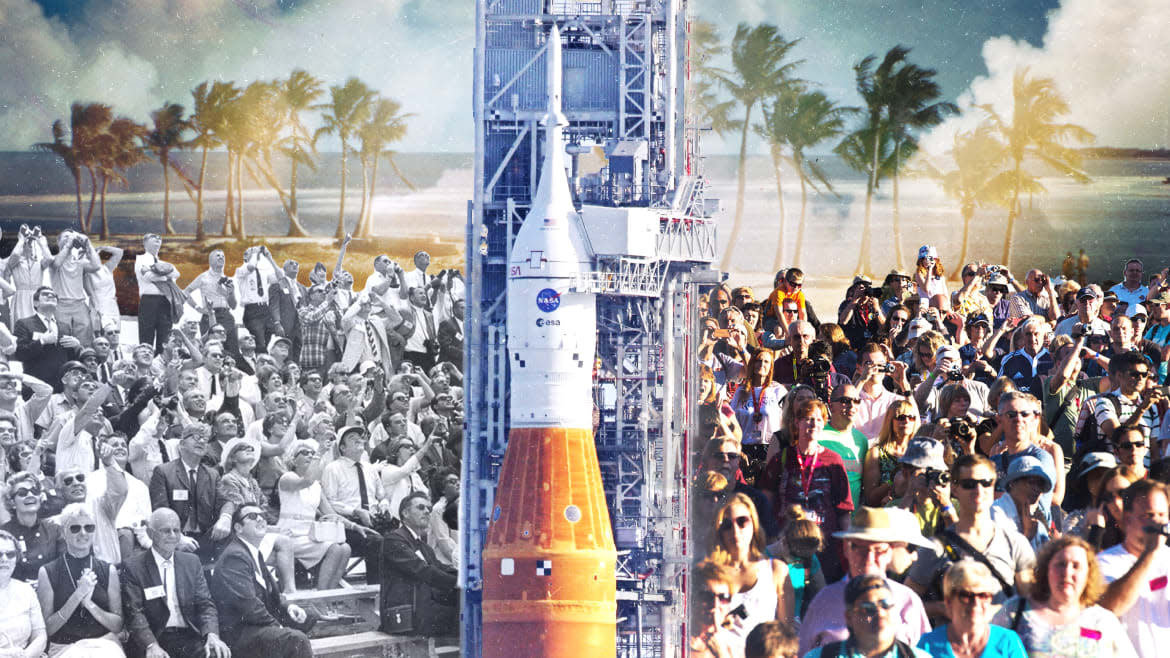
TITUSVILLE, Florida—This used to be a lazy paradise. Motels with jalousie windows ushered in the scent of salt and seaweed from the Indian River. Tourists in rented convertibles rumbled down scenic A1A on their way to Marineland. And the monster oysters at Bernard’s Surf in neighboring Cocoa Beach were just 25 cents a pop.
The aromas, attractions and oysters are still here, but you wouldn’t recognize it as the same place it was in the 1960s and ’70s. The same goes for any community within 50 miles of where big rockets now light up the sky on their way to more exotic destinations.
No, Titusville and surrounding Brevard County are a buzzing metropolis, thanks in part to NASA, Kennedy Space Center, and the rejuvenated American space program.
Things will take a decidedly upward turn Monday at 8:33 a.m. Eastern Time, when the biggest rocket NASA has ever built—the 32-story, 5.8 million-pound Space Launch System (SLS)—is set to blast off and send its next-generation Orion deep space exploration vehicle on a crewless journey around the moon and back. If all goes well within a span of 42 days, Orion will return to Earth and splash down in the Pacific Ocean.
The mission, Artemis 1, is designed to set the stage for an eventual return of NASA astronauts to the surface of the moon—perhaps in just a few years.
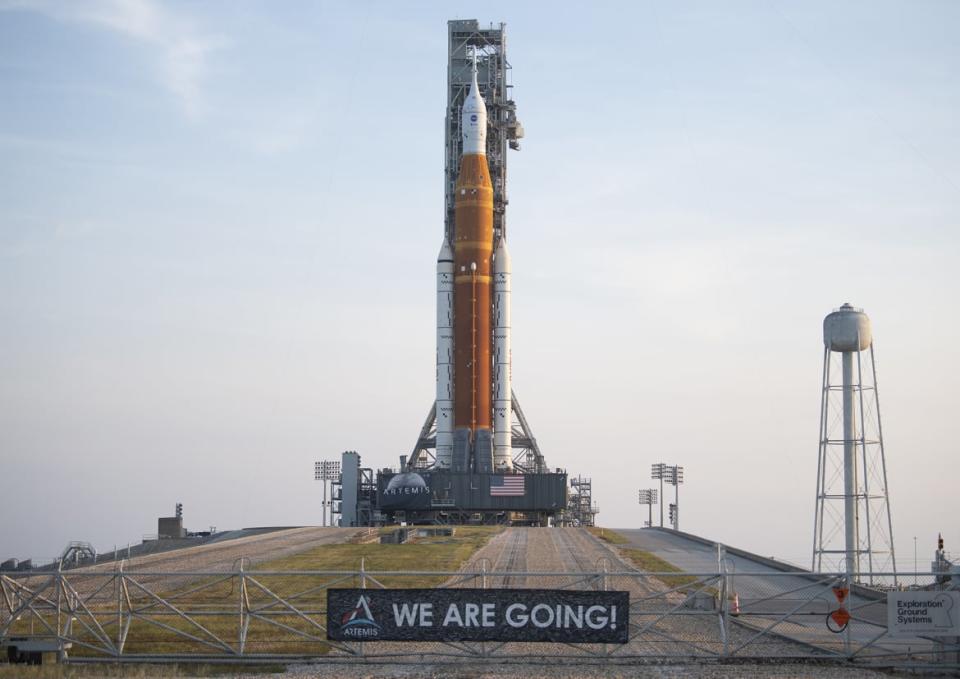
The NASA's Space Launch System (SLS) rocket with the Orion spacecraft aboard is seen atop the mobile launcher at Launch Pad 39B at the Kennedy Space Center on August 17, 2022 in Cape Canaveral, Florida.
More than 200,000 visitors are expected to be in place to watch the action within the two-hour launch window. Hotels have been booked for months, restaurant reservations require an act of Congress, and Sunday traffic could be a bumper-bending nightmare. Adding to the congestion will be thousands of people disembarking from five cruise ships docked at Port Canaveral.
As they did for the Space Shuttle launches, throngs from the Disney World area could pour onto the east-bound Beachline Expressway that links Orlando to the space coast and turn it into a parking lot. And like those shuttles from long ago, once Artemis gets off the ground, most of the 200,000 people will leave to go back home—all at the same time.
“Disharmonic convergence’’ is how Brevard County Emergency Management describes the mess about to unfold.
“Anticipate major gridlock everywhere,’’ said spokesman Don Walker. “And the launch is happening on a workday, when people are going to their jobs and kids are on school buses.’’
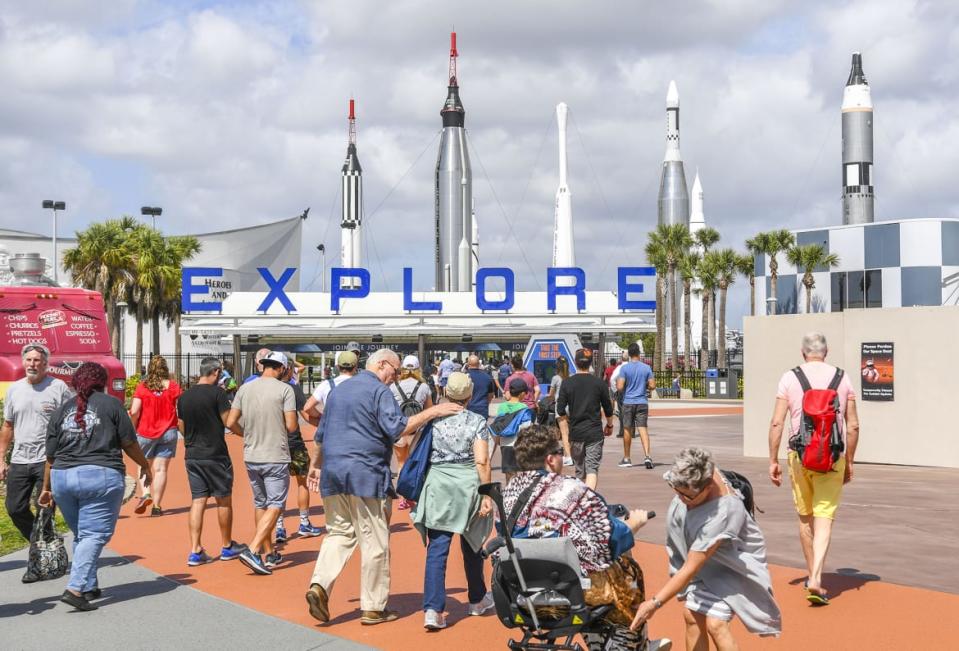
People arrive to tour The Kennedy Space Center Visitors Complex which draws nearly two million visitors per year to the Space Coast.
But others will embrace the chaos, including local businesses more than happy to accommodate those in need.
“This is going to be huge,’’ Greg Holladay, general manager of the Dixie Crossroads, a popular seafood restaurant in Titusville, told The Daily Beast. “And the impact of Artemis going forward is going to be huge for Titusville when NASA has the [crewed] launches. A lot of our customers are coming from other states to work for the space program, so the housing market is booming.’’
This weekend, Holladay expects double or even triple the number of customers over the normal 1,000 or so on a combined Saturday and Sunday. To prepare for the onslaught of hungry visitors, he’s beefed up his staff from 50 to 75 people.
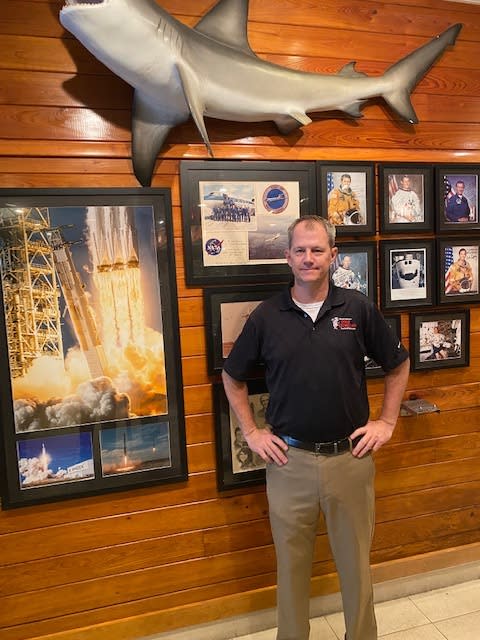
Greg Holladay, general manager of the Dixie Crossroads restaurant in Titusville.
The same goes for hotels and motels. Calls from The Daily Beast to more than a dozen in the area underscore the blitz: no vacancies, and most had been booked since the spring. Even with an increase in construction—there are currently 10,734 hotel rooms in Brevard County—the Artemis demand overwhelmed supply like a tsunami.
And most developers are hedging bets that the Artemis program will make long-term investments worthwhile. Planners aren’t just building more hotels—they are tailoring them as platforms with unrestricted views of rocket launches, said Peter Cranis, executive director of the Florida Space Coast Office of Tourism.
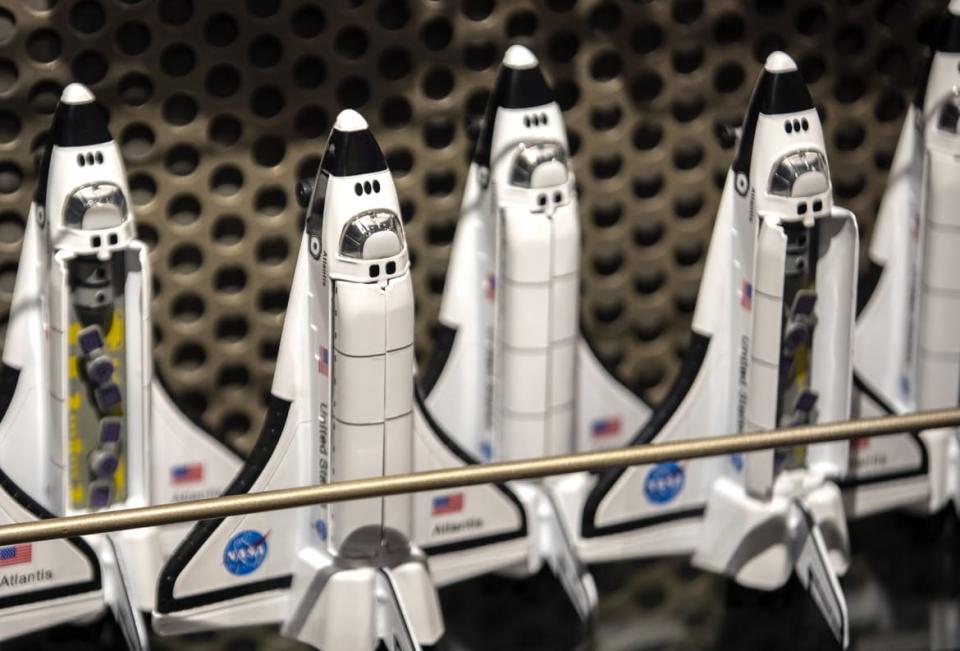
Space flight memorabilia for sale at the Courtyard Titusville - Kennedy Space Center hotel in Brevard County, Florida, on March 29, 2022.
“Over the last couple of years there’s been a hotel-building boom on the Space Coast where we’ve added over 1,500 new rooms to our inventory,’’ he said, “including hotels in Titusville with prime launch view rooms and decks.’’
Private Party, Public Places
The emphasis on space has injected life into Titusville and the neighboring cities of Cocoa Beach, Port St. John, Merritt Island, Rockledge, and Melbourne. They benefited from the Mercury, Gemini and Apollo days, as well as 30 years of the Space Shuttle program, which ended in 2011.
That’s when people expected a downturn, but the ghost never came to town. After all, the area still had its attractions: Florida’s second-most active cruise ship port; affordable real estate and cost of living; and access to exceptional boating waterways, fishing, and beaches north and south of the 140,000-acre Merritt Island National Wildlife Preserve.
It also has something else: jobs from private space ventures.
In the decade since the Space Shuttle was shuttered, commercial firms such as SpaceX and Blue Origin began using the launch complexes at Kennedy and Cape Canaveral Air Force Station, keeping people employed and generating new business for locals.
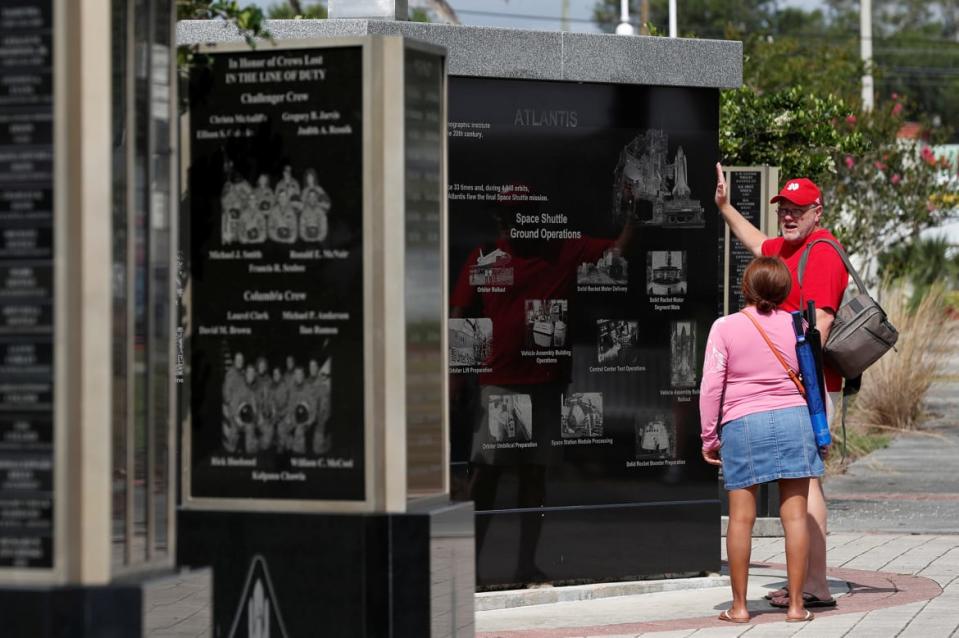
People visit Space View Park in Titusville, Florida on May 30, 2020.
The presence of more than 90 private sector partners and nearly 250 partnership agreements are feeding Titusville and neighboring communities as they enable NASA to embark on a new era of space exploration. In turn, the agency injects about $5.2 billion into Florida’s economy each year, according to the Kennedy Space Center 2021 Economic Impact Study.
“It’s unbelievable the activity since the shuttle,’’ said Lynda Weatherman, president of the Economic Development Commission in Rockledge. “Now you have two and three launches a week. If you look at our economy, with all the launch activity alone, it’s profound. The point is we were able to diversify the space market since the shuttle program went down. And now we have Artemis to look forward to.’’
The Biggest Rocket Ever Built
The Artemis program—named for the Greek goddess whose twin is Apollo—is a giant among modern technology endeavors. SLS is the world’s largest rocket and stands taller than the Statue of Liberty. It might be compared to the Saturn V of the Apollo program from the 1960s in size, ambition, lunar objective—and of course, price tag.
Cost of the upcoming mission, including all the planning and support, is $4.1 billion. By the time NASA sends astronauts on an orbital trip around the moon on Artemis 2 in 2024, the agency will have invested nearly $93 billion in the program. Artemis 3 will follow up with returning human boots to the lunar surface in 2025 (though experts widely expect that launch date to slide by one or two years at least).
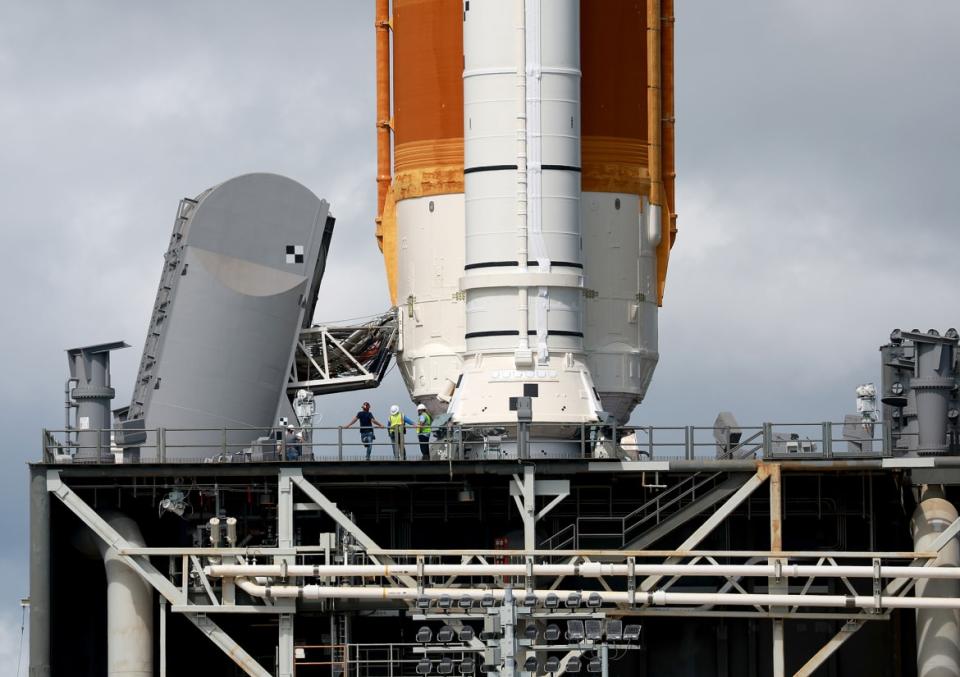
Workers continue to prepare NASA’s Artemis I rocket as it sits on launch pad 39-B at Kennedy Space Center for an unmanned flight around the moon on August 25, 2022 in Cape Canaveral, Florida.
Costs aside, both the Artemis and Apollo programs are watersheds in American history, and her own life, added Weatherman.
“I remember back in the summer of 1969 watching the Apollo 11 moon landing with my parents, and how thrilling that was,’’ she said. “And now I’m watching America go back to the moon after all this time. So I’ll see both in my lifetime, and it’s incredible I’m able to witness this, of having Apollo and Artemis as bookends in my life. I feel like this is next great era in space.’’
It starts with Monday’s mission. Artemis 1 is meant to test the Orion spacecraft systems as it travels 280,000 miles from Earth and 40,000 miles beyond the far side of the moon, and as it safely reenters Earth’s atmosphere and splashes down off the coast of California. This data is crucial to all of the next Artemis missions, which will feature a live crew of astronauts on board..
The SLS (consisting of a main booster and two smaller twin boosters on the side) will ascend on a controlled explosion of 8.8 million pounds of thrust. In clear skies, it can be seen up and down the East Coast of the U.S. The white exhaust contrail will drift for hours in the wind, a silent remnant of the ear-splitting noise and ground-shaking vibration that preceded it.
That alone is worth the price of admission, said Janis Shellabarger, an agent with Titusville Travel, whose husband was a union pipe fitter at the space center’s launch pads.
“We’re so happy and thrilled and excited about this launch, and we expect a great turnout,’’ she told The Daily Beast. “The Artemis program will be such a boost for our community for a long time, even though we take for granted all the things NASA has given us.’’
Tick-Tock
With the countdown on, and all systems running smoothly, NASA officials hope to announce the coveted “go for launch’’ on Monday morning. But delays are part of space history: In the course of 118 out of 135 shuttle missions, for instance, 71 were postponed, while only 47 blasted off on time.
If Artemis encounters bad weather, or a small technical glitch, it has two more chances on Sept. 2 and 5. You can bet a lot of people will stick around.
“I wouldn’t be surprised if it’s delayed,’’ Holladay said with a laugh. “But I wouldn’t mind because it would mean more people staying here and adding to our economy.’’
Get the Daily Beast's biggest scoops and scandals delivered right to your inbox. Sign up now.
Stay informed and gain unlimited access to the Daily Beast's unmatched reporting. Subscribe now.
